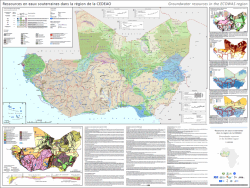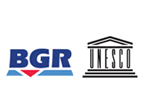Groundwater Resources in the ECOWAS Region
Background:
The Economic Community of West African States (ECOWAS) promotes economic integration and regional cooperation in its fifteen member countries. Groundwater is a vital regional water source for agricultural, industrial, and domestic use, underpinning economic prosperity and human well-being.
Groundwater offers considerable potential to support further social and economic development, but there are many challenges for its sustainable management, including rapidly growing and urbanising populations, industrial development, and climate and environmental change.
 Map "Groundwater resources in the ECOWAS region 1 : 5 000 000"
Map "Groundwater resources in the ECOWAS region 1 : 5 000 000"
Hydrogeological information is essential for ECOWAS member states to undertake effective groundwater management and support the strategic, sustainable development of new goundwater resources, with consequent lasting socio-economic benefits across West Africa.
The main map and inset maps capture and standardise existing groundwater data and understanding developed in the ECOWAS countries. The expected aquifer productivity map updates older regional hydrogeological maps of West Africa, to give a consistent regional overview not available from individual national maps. It provides a quantitative assessment of aquifer productivity, as a measure of groundwater potential, high lighting the suitability of aquifers for water supply at different scales and the physical limits of groundwater development potential.
Building on readily available data, the expected aquifer productivity map and the accompanying thematic inset maps show the potential for assimilating and harmonising existing hydrogeological information to improve regional groundwater mapping across Africa.
Expected aquifer productivity:
The expected aquifer productivity map shows a quantitative estimate of groundwater potential of the uppermost aquifer. For each hydrogeological unit, aquifer productivity is represented by the combination of aquifer flow type (colour) and an independent, literature-based estimate of expected borehole yield (lightness) for a properly sited and constructed borehole. The legend is based on the guide Hydrogeological Maps – A Guide and a Standard Legend developed by IAH/IAHS/UNESCO working groups (Struckmeier & Margat, 1995).
Borehole yield data were compiled from a meta-survey of relevant hydrogeological literature, with a strong focus on review papers summarising detailed local studies. Mapped hydrogeological units were assigned to one of five yield classes, based on the ability of each unit to provide water supplies for different uses. Basement aquifer classification was refined using regional productivity data subdivided by structural domain, predominant lithology and average regolith thickness.
The boundaries between borehole yield (expected aquifer productivity) classes are not absolute, but are estimates of the expected range in yields of well sited and constructed boreholes. Individual borehole yields may vary substantially above or below the given ranges. Additionally, aquifers in arid areas where modern recharge is very low may have high intrinsic productivity, but virtually all groundwater storage is likely to be non-renewable.
Map methodology:
Aquifers have been divided into hydrogeological units, primarily based on geological units as shown on two base maps:
a) the Carte hydrogéologique de l'Afrique, 1 : 1 000 000 (Seguin, 2016),
b) a harmonised version of the hydrogeological country maps of the Africa Groundwater Atlas (BGS, 2019).
These base maps were combined and revised using larger-scale sub-regional and national geological maps and were amended where necessary for more detailed differentiation of hydrogeological units, drawing particularly on these sources for Niger (Greigert & Pougnet, 1966), Nigeria (Dessauvagie, 1974), Mali (Bassot et al., 1980 and Girard et al., 1998) and Ghana (Carney et al., 2010). Harmonisation of geological linework and hydrogeological attribution focused on the hydrogeological relevance of the geological units, with compromise between the mapped geometry of geological units and a consistent classification of hydrogeological attributes. Geological descriptions are aggregated into fifteen generalised lithological classes that distinguish the four predominant aquifer flow types: porous (unconsolidated geological units), porous and fractured (consolidated and partly consolidated), fractured, and karst (both consolidated).
Superficial unconsolidated deposits, mostly of Quaternary age, frequently overlie bedrock aquifers. They are differentiated according to their hydrogeological significance: for example, aeolian deposits (dune fields, ergs, sand sheets) and clay-dominated lacustrine sediments generally do not contain useable groundwater; while alluvial and fluvial deposits may have locally significant groundwater resources.
Inset maps and diagrams:
- Structural map
- Sedimentary basins isopachs
- Fluoride
- Arsenic
- Groundwater recharge
- Groundwater level hydrographs
Recommended citation:
BGR, BGS, BRGM, EAWAG & UNESCO (2022): Ressources en eaux souterraines dans la région de la CEDEAO – Groundwater resources in the ECOWAS region. 1 : 5 000 000. doi: 10.25928/GWR-ECOWAS.1
References:
Main map
- BASSOT J-P, DIALLO M, TRAORÉ H & MÉLOUX J (1980): République du Mali. Carte géologique. 1 : 1 500 000. Direction Nationale de la Géologie et des Mines (DNGM) / Bureau de recherches géologiques et minières (BRGM).
- BRITISH GEOLOGICAL SURVEY (2019): Africa Groundwater Atlas. Accessed: 11/2021. https://www2.bgs.ac.uk/africagroundwateratlas/index.cfm
- BRITISH GEOLOGICAL SURVEY (2019): Africa Groundwater Atlas Country Hydrogeology Maps. Accessed: 11/2021. https://www2.bgs.ac.uk/africagroundwateratlas/downloadGIS.html
- CARNEY J, JORDAN C, THOMAS C, CONDON D, KEMP S & DUODO J (2010): Lithostratigraphy, sedimentation and evolution of the Volta Basin in Ghana. Precambrian Research, 183 (4), 701-724.
- DESSAUVAGIE T (1974): Geological Map of Nigeria. The Nigerian Mining, Geological & Metallurgical Society.
- GIRARD P, CHEVALIER J, YERGEAU M, GOULET N, MALO M & LORITE P (1998): République du Mali. Carte de Compilation Géologique. Direction Nationale de la Géologie et des Mines (DNGM) / Kilborn Tecsult Inc.
- GREIGERT J & POUGNET R (1966): République du Niger. Carte Géologique. 1 : 2 000 000. Bureau de recherches géologiques et minières (BRGM).
- MILESI J-P, FEYBESSE J-L, PINNA P, DESCHAMPS Y, KAMPUNZU HAB, MUHONGO S, LESCUYER J-L & TOTEU SF (2004): Géologie et principaux gisements de l’Afrique à l’échelle du 1 : 10 000 000 et 1 : 2 000 000, in LESCUYER J-L (2005): Projet Réseau SIGAfrique. Rapport final, BRGM/RP-54328-FR. Bureau de recherches géologiques et minières (BRGM).
- SEGUIN J-J (2016): Carte hydrogéologique de l’Afrique à 1 : 10 000 000 – Hydrogeological map of Africa at 1 : 10 000 000. Bureau de recherches géologiques et minières (BRGM).
- STRUCKMEIER, W. F. & MARGAT, J. (1995): Hydrogeological Maps - A Guide and a Standard Legend. – International Association of Hydrogeologists (IAH), Int. Contrib. to Hydrogeol. 17: 177 p.; Heise (Hanover). (PDF, 10 MB)
Inset maps
- AMINI M, ABBASPOUR K, BERG M, WINKEL L, HUG S, HOEHN E, YANG H & JOHNSON C (2008): Statistical Modeling of Global Geogenic Arsenic Contamination in Groundwater. Environmental Science & Technology, 42 (10), 3669–3675.
- CUTHBERT M, TAYLOR R, FAVREAU G et al. (2019): Observed controls on resilience of groundwater to climate variability in sub-Saharan Africa. Nature, 572 (7768), 230–234.
- MACDONALD A, LARK R, TAYLOR R, ABIYE T, FALLAS H, FAVREAU G, GONI I, KEBEDE S, SCANLON B, SORENSEN J, TIJANI M, UPTON K & WEST C (2021): Mapping groundwater recharge in Africa from ground observations and implications for water security. Environmental Research Letters, 16 (3), 034012.
- MILÉSI J-P, FRIZON DE LAMOTTE D, DE KOCK G, & TOTEU F (2010): Carte tectonique de l’Afrique - Tectonic map of Africa. 1 : 10 000 000. Commission de la carte géologique du monde (CCGM).
- PODGORSKI J & BERG M (2020): Global threat of arsenic in groundwater. Science, 368 (6493), 845-850.
- SPENGLER A, CASTELAIN J, GAUVIN J & LEROY M (1966): Le bassin secondaire-tertiaire du Sénégal. In: REYRE D (ed.), Bassins sédimentaires du littoral africain. Sedimentary basins of the African coasts. Association des services géologiques africains (ASGA), 80–94.
- THIÉBLEMONT D, LIÉGEOIS J-P, FERNANDEZ-ALONSO M, OUABADI A, LE GALL B, MAURY R, JALLUDIN M, VIDAL M, OUATTARA GBÉLE C, TCHAMÉNI R, MICHARD A, NEHLIG P, ROSSI P & CHENE F (2016): Carte Géologique de l’Afrique – Geological Map of Africa. 1 : 10 000 000. Commission de la carte géologique du monde (CCGM) & Bureau de recherches géologiques et minières (BRGM).
Contact
